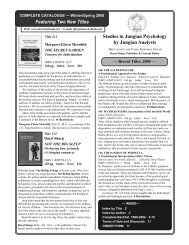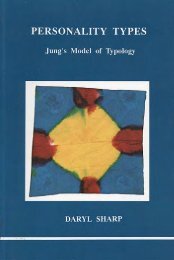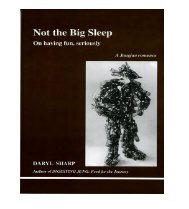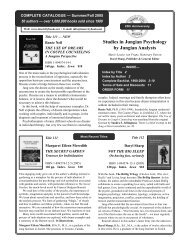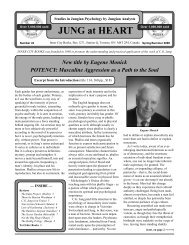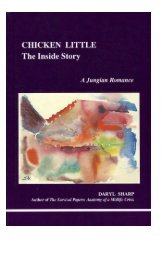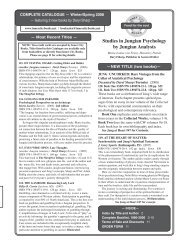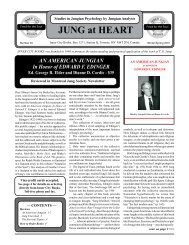Digesting Jung: Food for the Journey - Inner City Books
Digesting Jung: Food for the Journey - Inner City Books
Digesting Jung: Food for the Journey - Inner City Books
Create successful ePaper yourself
Turn your PDF publications into a flip-book with our unique Google optimized e-Paper software.
96 The Religious Attitude and Soul-Making<br />
goblins and horrors under <strong>the</strong> bed—“<strong>the</strong> attitude peculiar to a consciousness<br />
which has been changed by experience of <strong>the</strong> numinosum”<br />
90 —which is to say, <strong>the</strong> unknown.<br />
Thus someone in a conflict situation, he said, has to rely on<br />
divine com<strong>for</strong>t and mediation . . . . an autonomous psychic happening,<br />
a hush that follows <strong>the</strong> storm, a reconciling light in <strong>the</strong> darkness<br />
. . . secretly bringing order into <strong>the</strong> chaos of his soul. 91<br />
Although <strong>Jung</strong> often used <strong>the</strong> word “soul” in its traditional <strong>the</strong>ological<br />
sense, he strictly limited its psychological meaning. “By<br />
soul,” he writes, “I understand a clearly demarcated functional<br />
complex that can best be described as ‘personality.’ ” 92 Thus soulmaking,<br />
in this secular sense, can be seen as a natural consequence<br />
of differentiating and assimilating previously unconscious contents,<br />
particularly shadow and anima/animus.<br />
Personally, I experience soul when I stare at <strong>the</strong> wall in <strong>the</strong> still<br />
of <strong>the</strong> night. Soul is <strong>the</strong>re when I am in conflict with myself, when I<br />
struggle <strong>for</strong> answers. Soul is what I am, as opposed to what I seem<br />
to be. Soul is <strong>for</strong>ged in <strong>the</strong> interactions between me and my inner<br />
complexes (persona, shadow, anima, etc.), between me and my<br />
outer companions (friends, family, colleagues), and I see abundant<br />
evidence of it daily in my analytic practice.<br />
At times of transition from one stage of life to ano<strong>the</strong>r, traditional<br />
religious imagery often appears in dreams. A childless<br />
woman in her <strong>for</strong>ties dreams of baptizing her new-born. A man in<br />
his fifties dreams of finding a long-lost baby boy under a pile of<br />
rubble in <strong>the</strong> basement of a church. People dream of being priests<br />
or nuns, of celebrating Mass, of family seders, of pilgrimages, of<br />
mountainous journeys, fearful descents into black holes, wandering<br />
in <strong>the</strong> desert. A shopping mall becomes a mosque. Shrines magically<br />
appear in parking lots. Virgin births and divine children—<br />
born walking and speaking—are not rare.<br />
90 “Psychology and Religion,” Psychology and Religion, CW 11, par. 9.<br />
91 “A Psychological Approach to <strong>the</strong> Dogma of <strong>the</strong> Trinity,” ibid., par. 260.<br />
92 “Definitions,” Psychological Types, CW 6, par. 797.



